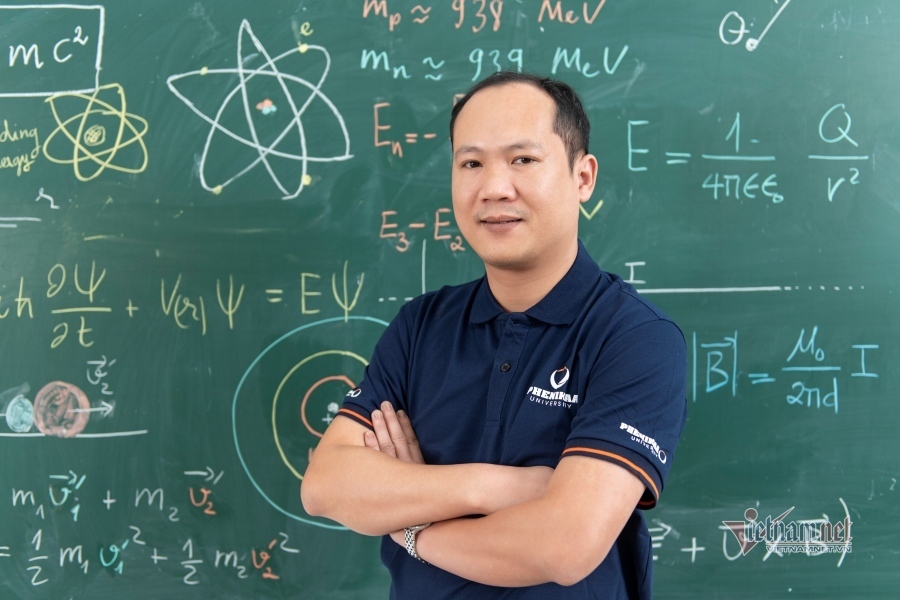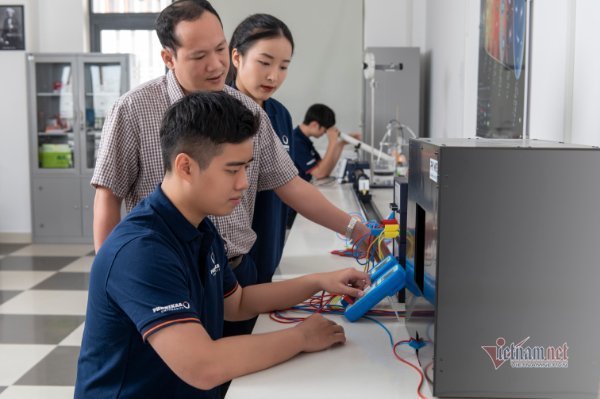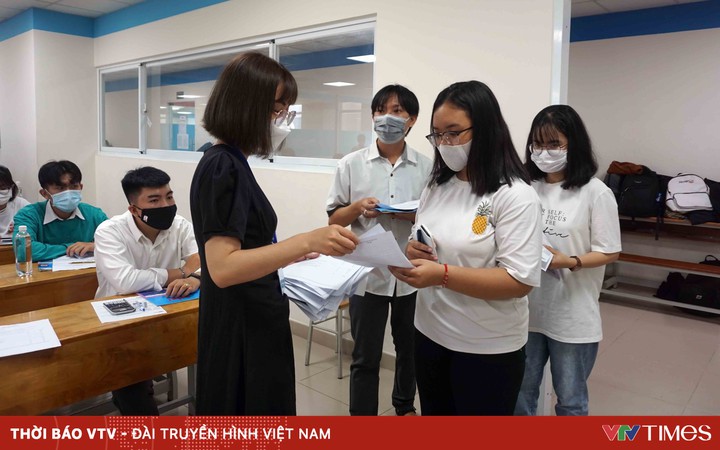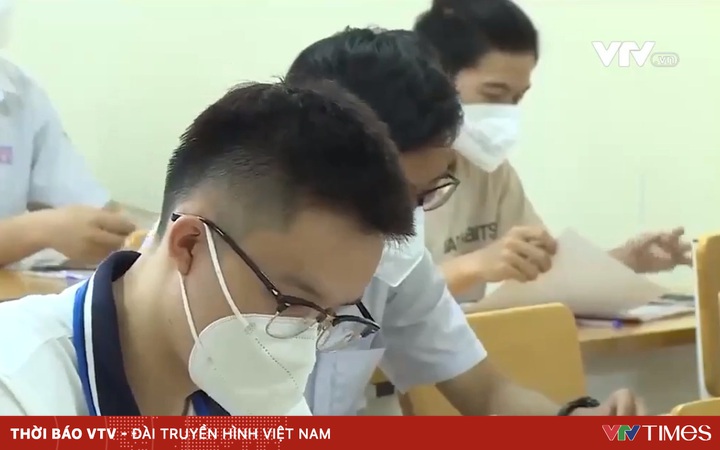Youngest professor in 2021: Triangle model helps develop quality research
Professor Phung Van Dong is the youngest person to be recognized as a professor this year. Having chosen to do a PhD in the country, although there are many opportunities to go abroad, Professor Dong said, for me, it is a fortunate thing.
Prof. Phung Van Dong (Strong Research Team Leader) High-energy physics and cosmology, Phenikaa University) was born in 1981, was an alumnus of the University of Natural Sciences, Vietnam National University, Hanoi. For him, this is a quite favorable environment for himself to develop his love for Physics naturally, then have the opportunity to approach and do in-depth research on Theoretical Physics.
After graduating, Mr. Dong chose to continue studying for a master’s degree and do a doctorate in the country, although at that time, many people after graduation chose to study abroad. At that time, he explained, he was being led by good physics professors with good research groups at the University of Natural Sciences and the Institute of Physics of the Vietnam Academy of Science and Technology. Moreover, for the study of Theoretical Physics, it still depends mainly on the human factor.
Although he was a PhD student entirely in the country, in only the first year, Mr. Dong completed his doctoral thesis with 5 works on the proposal and development of the economical 3-3-1 model, published in various publications. The most prestigious magazine in the field (including 4 articles in Physical Review EASY and 1 post in Physics Letters REMOVED), was awarded the privilege of successfully defending the grassroots thesis in October 2007. However, at this time, Mr. Dong encountered a problem because the thesis was written in English and it took 2 years to solve the problem. He received his doctorate in 2009, when he had a total of 14 works.
After completing the grassroots doctoral program, Mr. Dong chose to go abroad as a post-doctoral trainee at the Japan High Energy Acceleration Research Center (KEK, Japan), then the Organization European Nuclear Research (CERN, Switzerland) and the Taiwan Academy of Sciences (AS, Taiwan), to expand research directions. After completing his post-doctoral internships, he decided to return to work in the country.

Professor Phung Van Dong is the youngest person to be recognized as a professor this year.
Returning while having the opportunity to work in professional environments – which you say is quite favorable for research – for some special reason?
Prof. Phung Van Dong: Being abroad for a while, I found myself getting a lot of expertise, but also had to make a lot of trade-offs. I love life in Vietnam, enjoy meeting friends, old study group, and family as well.
After doing postdoc, I realized that I have had a certain maturity in my work and profession. Specifically, my field of study is Theoretical Physics, which does not depend too much on experimental equipment, so I can work anywhere.
Basic research is inherently borderless, as learning materials, research results, and experiments are updated and globally disseminated. If you regularly update information, exchange expertise with colleagues in the group and internationally, most of the obstacles can be solved.
In 2016, he received the Ta Quang Buu Award for the outstanding scientific work of a young scientist. Since then, how has your research progressed?
Prof. Phung Van Dong: The project that won the Ta Quang Buu award is named “3-3-1-1 model for dark matter” marked my first step into the new field of dark matter. There, I developed a theory that explains the universal existence of dark matter in the universe, in addition to providing mass neutrinos.
The above approach suggests that the problems of particle physics and cosmology can be considered in a single theory, however their dynamic origins, as well as the connection between particle physics and early universe, not yet elucidated.
We realized that ordinary matter is governed by fundamental interactions, produced by electric charge, weak charge, color charge, and momentum energy. So is there an analogy for dark matter and other new physics, produced by a new type of charge, called dark charge?
After a series of works on left-right asymmetry, we found that the dark product is the image of the charge, with the mirror being the BL product that exists in the standard model. The results obtained are quite surprising, all elementary particles, in addition to possessing ordinary dynamic products, also have dark products.
The dynamic dark product that causes dark matter to be stable and its distribution today, in addition to the mass neutrinos, caused early cosmic inflation and the observed matter and antimatter asymmetry. Some of the recently measured physical anomalies can also be explained by the dark product.
A special work on dark products is “The inverse principle for neutrino mass and dark matter” It was later published in a magazine Physical Review D Rapid Communication.
I proposed to build a research group at Phenikaa University, to solve the problems of high-energy physics and cosmology, in which to find the dark product connecting elementary particles and the evolution of the universe. early is one of the central problems. Every year our group publishes about 10 articles on proposed issues.
Our research results have significantly contributed to bringing Phenikaa University to the top of the Nature Index of Vietnam and Vietnam to the top 50 countries on the Nature Index. This is a ranking of research quality of universities and countries by the prestigious Nature Research organization.
18 years of doing research with 54 published works, most of which are published in strong international journals of the industry, are you satisfied with these numbers?
Prof. Phung Van Dong: In fact, for researchers, the number of papers is not so important as getting breakthrough results.
In fact, many professors after receiving the Nobel Prize have a small number of publications, especially in the fields of basic research. They worked on a math problem for many years and came up with results that describe the truth, which are verified by experiment. These are influential works.
I also know that there are research groups with a large number of members, but each year they publish only a few very elaborate papers. Their criteria is to find the best results or be useful to the professional community.
Although the number of publications is necessary to gradually increase the quality of research, without breakthrough results, it is not meaningful to have 100 works. Our team is also growing according to that criterion.

Previously, research often depended heavily on single individuals, so the number of quality publications was still modest. But now, there are many strong research groups, strong research universities – factors that are considered to promote international publication. How do you rate the quantity and quality of international publications in Vietnam today?
Prof. Phung Van Dong: It should be acknowledged that, although the country had many difficulties in the past, we have always had good works, especially in the fields of basic research, associated with the names of senior scientists.
Then, in order to increase the quantity and quality of research, we developed research groups associated with human resource training right in universities, with research conditions, investment from public funds. and private schools, and the cooperation of the international community is improved. This is the right direction.
And, the strong investment of the NAFOSTED Foundation over the past 10 years, with its focus on publication quality, has also resulted in a number of well-published works, increasing year by year.
However, in recent years, although the number of publications in Vietnam has increased dramatically, it should be boldly acknowledged that the number of quality works has not increased proportionally. This may be because some groups are not aware of the importance of research quality, as well as building internal resources.
So how does Vietnam develop the quantity of good quality research?
Prof. Phung Van Dong: It is necessary to promote cooperation in research and training of adjacent human resources. Collaboration helps to improve the quantity and quality of research and can solve big problems together. Training helps to keep knowledge fresh, with additional human resources, if the teacher can’t solve the problem, the juniors will continue to work. Those are the problems of our Vietnamese people.

To have science comparable to developed countries in the not too distant future, the rule here is the triangle model. How to make the bottom wider and stronger, the higher the peak will be pushed. Thus, we need to have a strong research human resource, employ young doctors and capable scientists, and encourage the participation of the private sector and the international community to come to Vietnam to work.
In addition, it is also necessary to encourage capable scientists to open research groups and build research schools right in universities, associated with training responsibilities; boldly acknowledge quality publications and doctoral theses with excellent research results.
“The most interesting thing on the journey of doing scientific research is encountering difficult, seemingly insurmountable problems. There are projects that take up to a year, even a few years to carry out. But the low point of difficulties is also where knowledge is born and is the driving force for development. When we work enough, at some point we will “clear the way” and gain great joy. My feeling of great joy came when I studied the work that was awarded the Ta Quang Buu Prize in 2016. The theory on which I was based has existed for a long time, but no one has discovered its properties. it may contain a new symmetry for dark matter. That work continues to guide our team’s future developments. That is the greatest joy of scientists.” Prof. Phung Van Dong |
Thuy Nga(Perform)
at Blogtuan.info – Source: vietnamnet.vn – Read the original article here



